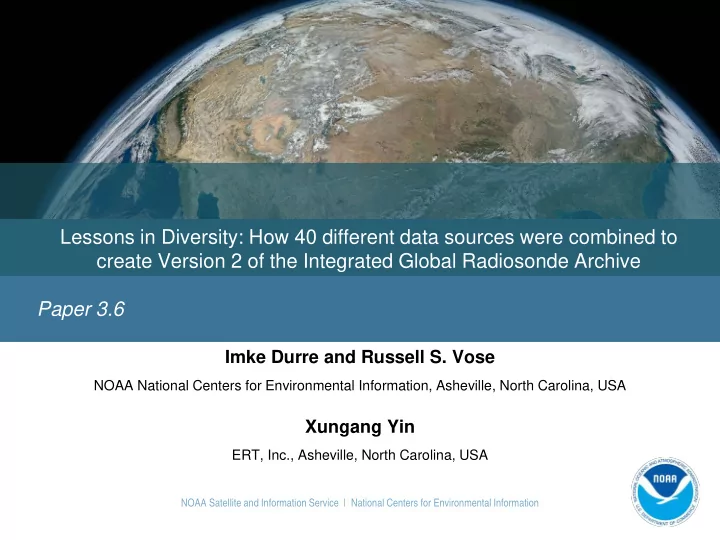

Lessons in Diversity: How 40 different data sources were combined to create Version 2 of the Integrated Global Radiosonde Archive Paper 3.6 Imke Durre and Russell S. Vose NOAA National Centers for Environmental Information, Asheville, North Carolina, USA Xungang Yin ERT, Inc., Asheville, North Carolina, USA NOAA Satellite and Information Service | National Centers for Environmental Information
Integrated Global Radiosonde Archive (IGRA) Observations: radiosonde and pilot balloon Coverage: global land, 1905-present Example applications: reanalysis input, climate assessments, satellite verification, air pollution modeling Created by merging data from 40 sources containing 11,500 station records 2 NATIONAL CENTERS FOR ENVIRONMENTAL INFORMATION
The Classic Duplicate Elimination Problem Which source station records should be combined to form one IGRA station? Input: - Multiple, sometimes overlapping, time series for the same location Desired output: - One time series per location, containing as much data as possible - No data duplication between distinct locations Challenges: - Imprecise and changing station locations - Various names and station identifiers for the same location - Differences in data precision 3 NATIONAL CENTERS FOR ENVIRONMENTAL INFORMATION
The IGRA Solution Decision-making algorithm: Input: all ~11,500 source stations Steps: 1. Identify matching pairs of source stations on the basis of data and metadata. 2. Arrange paired stations into groups. 3. Resolve conflicts . Output: final groups of source stations that constitute IGRA stations 4 NATIONAL CENTERS FOR ENVIRONMENTAL INFORMATION
Step 1: Find Pairs Compare data, station identifiers, station names, and station locations Example 1: Match Source: NCDC6301 Source: NCAR-MIT 100% data match, IDs match WBAN= 24233 WBAN= WMO= 72793 WMO= 72793 0.0 km apart NAME= Seattle Tacoma AP NAME= Seattle-Tacoma Intnl Example 2: Match Source: NCDC6301 Source: CDMP-USM No overlap, IDs and names match WBAN= 24233 WBAN= 24233 WMO= 72793 WMO= 3.1 km apart NAME= Seattle Tacoma AP NAME= Seattle - Tacoma Airport Example 3: Conflict Source: NCAR-MIT Source: NCDC6310 100% data match WBAN= WBAN= WMO= 72793 WMO= 72792 70.1 km apart NAME= Seattle-Tacoma Intnl NAME= OLYMPIA/MUNI (WASH) 5 NATIONAL CENTERS FOR ENVIRONMENTAL INFORMATION
Step 2: Identify Groups Classify connections between stations as: MATCH, SO-SO MATCH, CONFLICT, UNKNOWN, or SEPARATE. Form a group from each set of stations that are connected with matches or conflicts. Source Station name 1. usaf-ds3 SEATTLE-TACOMA INTL 2. ncdc6309 SEATTLE/TACOMA INTL 3. ncdc6310 SEATTLE-TACOMA INTNL 4. ncdc6301 SEATTLE TACOMA AP 5. chuan101 SEATTLE 3556 6. chuan101 SEATTLE 3557 7. cdmp-usm SEATTLE-TACOMA AIRPORT 8. ncar-mit SEATTLE-TACOMA INTNL 9. ncdc6301 OLYMPIA MUN I AP 10.ncdc6326 OLYMPIA/MUNI (WASH) 11.ncar-mit OLYMPIA/MUNI (WASH) 12.ncdc6310 OLYMPIA/MUNI (WASH) 6 NATIONAL CENTERS FOR ENVIRONMENTAL INFORMATION
Step 3: Resolve Conflicts 1 2 3 4 5 6 7 8 9 10 11 12 1 2 2 2 2 0 0 2 -1 -1 -1 -1 o Organize pairwise 2 2 2 2 2 0 0 2 -1 -1 -1 -1 comparison results 3 2 2 2 2 1 0 2 -1 -1 -1 -1 into one matrix per 4 2 2 2 2 0 2 2 -1 -1 -1 -1 group. 5 2 2 2 2 1 0 2 -1 -1 -1 -1 6 o Eliminate certain 0 0 1 0 1 0 0 -1 -1 -1 -1 source stations from 7 0 0 0 2 0 0 0 -1 -1 -1 -1 groups with conflicts. 8 2 2 2 2 2 0 0 -2 -1 -1 -2 9 -1 -1 -1 -1 -1 -1 -1 -2 2 2 2 o Split groups into 1 0 -1 -1 -1 -1 -1 -1 -1 -1 2 2 2 subgroups if needed. 1 1 -1 -1 -1 -1 -1 -1 -1 -1 2 2 2 1 2 -1 -1 -1 -1 -1 -1 -1 -2 2 2 2 7 NATIONAL CENTERS FOR ENVIRONMENTAL INFORMATION
Outcome One multi-source time series per location More data per location than from a single source Clean separation of data for obviously distinct locations Time series indicating change data sources over time at Seattle Airport 8 NATIONAL CENTERS FOR ENVIRONMENTAL INFORMATION
Number of Stations by Year in IGRA 1 and IGRA 2 9 NATIONAL CENTERS FOR ENVIRONMENTAL INFORMATION
IGRA 2 Station Map https://www.ncdc.noaa.gov/data-access/weather-balloon/integrated-global-radiosonde-archive/ 10 NATIONAL CENTERS FOR ENVIRONMENTAL INFORMATION
Recommend
More recommend